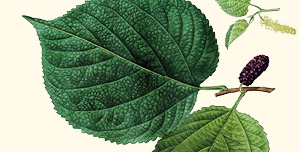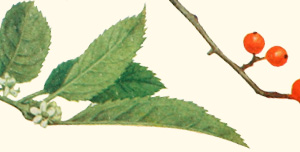There are many benefits to planting the right trees in the right places on your property. For a typical residence, trees can reduce annual heating and cooling costs by 8 to 12 percent and increase property values by 10 to 15 percent. They can also be used to address problems with soil erosion and poor drainage.
When deciding on a tree, it’s important to choose native species that are resilient to disease and adapted to your region’s climate and soil. Native species support natural ecosystems by providing habitat and food for birds, wildlife, and insects. In fact, the survival of some species is closely linked to native trees—brook trout, Pennsylvania’s state fish, were once called “hemlock trout” because of their abundance in streams shaded by these trees.
This infographic on planting trees based on their water needs will help you determine what type of trees are best for your property and how many you will need per acre.

Black walnut
Biodiversity Heritage Library
Black Walnut:
Grows 70-90’; best planted in woods, on slopes, or along streams; produces nuts in August and September.
Mature trees will intercept 5,954 gallons of stormwater, sequester 937 pounds of CO2, and provide an environmental and economic value of $296 on an annual basis. Estimated life span 250 years.

Chestnut oak
Biodiversity Heritage Library
Chestnut Oak:
Grows 50-80’; highly valuable to wildlife, flowers in May and produces acorns in late summer.
Mature trees will intercept 3,214 gallons of stormwater, sequester 869 pounds of CO2, and provide an environmental and economic value of $217 on an annual basis. Estimated life span 300 years.

Eastern white pine
Biodiversity Heritage Library
Eastern White Pine:
Grows 75-100’; evergreen; provides winter cover for wildlife.
Mature trees will intercept 2,609 gallons of stormwater, sequester 323 pounds of CO2, and provide an environmental and economic value of $106 on an annual basis. Estimated life span 200 years.

Pin oak
Biodiversity Heritage Library
Pin Oak:
Also known as willow oak; grows 80-100’; produces acorns for wildlife.
Mature trees will intercept 8,890 gallons of stormwater, sequester 2,462 pounds of CO2, and provide an environmental and economic value of $430 on an annual basis. Estimated life span 120 years.

Red maple
Biodiversity Heritage Library
Red Maple:
Grows 40-100’; is the earlies spring bloomer; and is adaptable to a variety of habitats, including swamps, uplands, hillsides and dunes.
Mature trees will intercept 3,472 gallons of stormwater, sequester 690 pounds of CO2, and provide an environmental and economic value of $194 on an annual basis. Estimated life span 90 years.

Persimmon
Biodiversity Heritage Library
Persimmon:
Grows 50-75’; produces orange and purple berries; is valuable to wildlife.
Mature trees will intercept 3,038 gallons of stormwater, sequester 623 pounds of CO2 and provide an environmental and economic value of $181 on an annual basis. Estimated life span 60 years.

Red mulberry
Biodiversity Heritage Library
Red Mulberry:
Grows 35-60’; best planted in floodplains, river valleys or hillsides; and produces red berries in summer.
Mature trees will intercept 3,915 gallons of stormwater, sequester 724 pounds of CO2, and provide an environmental and economic value of $204 an annual basis. Estimated life span 50 years.

Red oak
Biodiversity Heritage Library
Red Oak:
Grows 70-80’; provides acorns for wildlife; prefers uplands habitat.
Mature trees will intercept 4,793 gallons of stormwater, sequester 1,249 pounds of CO2, and provide an environmental and economic value of $275 on an annual basis. Estimated life span 200 years.

Serviceberry
Biodiversity Heritage Library
Serviceberry:
Grows 15-25’; used by 58 wildlife species and 35 bird species; and berries are edible for people.
Mature trees will intercept 220 gallons of stormwater, sequester 94 pounds of CO2, and provide an environmental and economic value of $30 on an annual basis. Estimated life span 50 years.

Shagbark hickory
Biodiversity Heritage Library
Shagbark Hickory:
Grows 70-100’; best planted in dry upland slopes, lowlands and valley; recognizable by attractive, peeling bark.
Mature trees will intercept 5,438 gallons of stormwater, sequester 924 pounds of CO2, and provide an environmental and economic value of $ 295 on an annual basis. Estimated life span 200 years.

Silky dogwood
Biodiversity Heritage Library
Silky Dogwood:
Grows 6-12’; highly valuable to wildlife; produces white flowers May through June, and blue berries in August.
Mature trees will intercept 74 gallons of stormwater, sequester 28 pounds of CO2, and provide an environmental and economic value of $15 on an annual basis. Estimated life span 80 years.

Silver maple
Biodiversity Heritage Library
Silver Maple:
Also known as white, river and soft maple; grows 50-100’; flowers in February and March and fruits in April and May.
Mature trees will intercept 6,537 gallons of stormwater, sequester 1,093 pounds of CO2, and provide an environmental and economic value of $266 on an annual basis. Estimated life span 130 years.

Sugar maple
Biodiversity Heritage Library
Sugar Maple:
Grows 60-100’; produces maple syrup and is known for it’s beautiful fall colors of yellow, orange and red.
Mature trees will intercept 7,694 gallons of stormwater, sequester 1,461 pounds of CO2, and provide an environmental and economic value of $361 on an annual basis. Estimated life span 350 years.

Swamp white oak
Biodiversity Heritage Library
Swamp White Oak:
Grows 60-100’; produces acorns for wildlife; prefers bottomlands, swamps and stream edges.
Mature trees will intercept 6,308 gallons of stormwater, sequester 1,841 pounds of CO2, and provide an environmental and economic value of $295 on an annual basis. Estimated life span 300 years.

White oak
Biodiversity Heritage Library
White Oak:
Maryland state tree; grows 75-100’; prefers dry to moist woods, and leaves may persist into winter.
Mature trees will intercept 8,008 gallons of stormwater, sequester 2,257 pounds of CO2, and provide an environmental and economic value of $404 on an annual basis. Estimated life span 300 years.

White spruce
Biodiversity Heritage Library
White Spruce:
Grows 40-60’ at maturity; great option for buffers and windbreaks; can grow in many soil types and moisture levels.
Mature trees will intercept 2,609 gallons of stormwater, sequester 323 pounds of CO2 and provide an environmental and economic value of $106 on an annual basis. Estimated life span: 275 years.

Winterberry
Biodiversity Heritage Library
Winterberry:
6-12’ at maturity; grows in swamps, thickets, and forested wetlands; its bright red berries are poisonous to humans and pets (including horses) but an important winter food source for various wild birds and animals, and are a popular component of autumn and winter displays.
Mature trees will intercept 74 gallons of stormwater, sequester 28 pounds of CO2 and provide an environmental and economic value of $15 on an annual basis. Estimated life span: 175 years.
Notes: Tree species stats resourced from U.S. Fish & Wildlife Service Native Plants for Wildlife Habitat and Conservation Landscaping Chesapeake Bay Watershed. Calculations from the National Tree Benefit Calculator and based on single family residential sites in southcentral Pennsylvania. Diameters at maturity are based on readily available literature. CO2 reduced includes sequestered and avoided. All values based on maturity diameter which each species reaches at different times due to varying growth rates.


